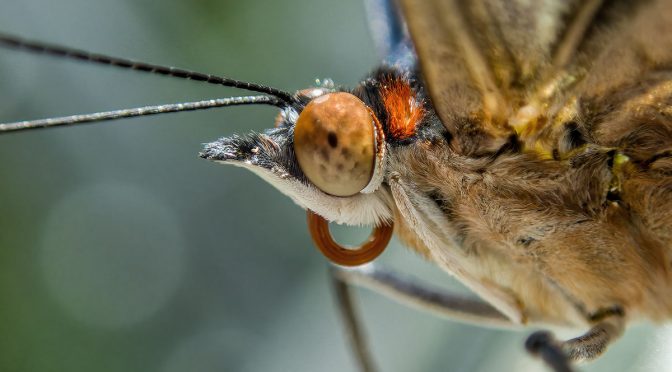This article shares a selection of tiny sensor butterfly macro photographs captured handheld with an Olympus TG-5 using its microscopic mode.
These photographs were captured a few years ago during a visit to the Niagara Butterfly Conservatory.
NOTE: Click on images to enlarge.

Since the butterflies are born and raised at the facility they are a lot more acclimatized to people.

This makes most of them less skittish and more approachable than butterflies found in the wild.

It also makes it much easier for a photographer to find subject butterflies, look for decent lighting in the facility, and adjust their shooting angle without scaring butterflies away.

I enjoy getting in very close to my subjects when capturing macro images, so the close focusing ability of the TG-5 suits my photographic style.

I also enjoy incorporating some of the environment in my butterfly images as it can help to provide context.

When capturing tiny sensor butterfly macro images it can be challenging to find an appropriate shooting angle where the background is distant enough to be blurred. When you compare the image above with the two that follow, you can see the advantage of getting in tighter to the subject in terms of creating background blur.


Photographing at a facility like the Niagara Butterfly Conservatory provides photographers with the opportunity move in extremely tight to subjects. For many of the photographs that follow, my TG-5 was so close to the subject butterflies that they were only few centimetres away from touching the front of my camera.







The Niagara Butterfly Conservatory is one of my favourite photographic locations, and I look forward to a post-COVID time when I can once again visit safely.

The Olympus TG-5 was my first ever Olympus camera. I was very pleasantly surprised with the image quality that it could produce, and the innovative technology (like the microscopic mode) packed into it. It was the TG-5 that made me curious about other Olympus products and prompted me to investigate further.

Technical Note
Photographs were captured hand-held using camera gear and technology as noted in the EXIF data. Images were produced from RAW files using my standard process. All photographs are displayed as full frame captures without any cropping.

How you can help keep this site advertising free
My intent is to keep this photography blog advertising free. If you enjoyed this article and/or my website and would like to support my work, you can purchase an eBook, or make a modest $10 donation through PayPal. Both are most appreciated. You can use the Donate button below. Larger donations can be made to… tom at tomstirr dot com… through PayPal.
Word of mouth is the best form of endorsement. If you like our website please let your friends and associates know about our work. Linking to this site or to specific articles is allowed with proper acknowledgement. Reproducing articles, or any of the images contained in them, on another website or in any social media posting is a Copyright infringement.
Article is Copyright 2021 Thomas Stirr. Images are Copyright 2019 Thomas Stirr. All rights reserved. No use, duplication or adaptation of any kind is allowed without written consent. If you see this article reproduced anywhere else it is an unauthorized and illegal use. Posting comments on offending websites and calling out individuals who steal intellectual property is always appreciated!


Only now – after commenting your latest post – I realized, that you have a page about the TG-5. And some stunning images here too… The eyes of those butterflies are just wonderful. So far I’ve found the TG-7 to be quite challenging in bright daylight, because of no viewfinder. But it seems like you can do wonders with it.
Hi Iikka,
Not having an EVF can make using a camera like the TG-7 more challenging to use. I used the Nikon 1 system exclusively for 4 years with the Nikon 1 J5 being one of my favourite cameras during this period. The J5 also does not have an EVF. When shooting in bright sunlight I had to get used to only using part of the rear screen that was not suffering from some glare, to compose my images. There was a leap of faith involved with this approach, but it did work quite well once I got used to it.
Tom
I agree with you I have a TG-6, and both macro lenses. I find that I use the TG-6 unless I need more working distance. I have been an Olympus user since 1984 and really enjoy your blog. Stay well and keep up the good work.
Keep well too Donald! Glad you are enjoying the blog!
Tom